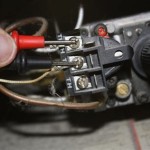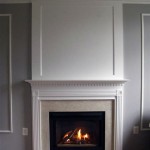Wood Mantel Enhancements for Brick Fireplaces
A brick fireplace serves as a classic focal point in many homes, evoking feelings of warmth and coziness. While the brick itself provides a rustic and enduring aesthetic, the addition of a wood mantel can significantly enhance its visual appeal and functional capabilities. A carefully chosen and installed wood mantel acts as a decorative shelf, a stylistic counterpoint to the brick, and a platform for personal expression. This article examines the various considerations involved in selecting and integrating a wood mantel with a brick fireplace, focusing on design options, safety precautions, installation techniques, and maintenance practices.
Design Considerations for Wood Mantels
The selection of a wood mantel for a brick fireplace involves careful consideration of several design elements. The style of the mantel should complement both the existing architectural style of the room and the inherent character of the brick fireplace. Various styles are available, ranging from rustic and traditional to modern and minimalist. A substantial, heavily textured wood mantel can accentuate a traditional or country-style interior, while a sleek, minimalist mantel crafted from a lighter wood may be more appropriate for a contemporary space.
The type of wood used in the mantel construction influences its appearance, durability, and cost. Common wood choices include oak, pine, maple, cherry, and walnut, each possessing unique grain patterns, color variations, and hardness characteristics. Oak, known for its strength and prominent grain, suits more traditional settings. Pine, a softer and more affordable option, can be stained or painted to match a wider range of aesthetics. Maple offers a smooth, clean look that is suitable for both modern and transitional designs. Cherry provides a rich, reddish-brown hue that adds warmth and elegance. Walnut, a premium hardwood, is valued for its deep color and distinctive grain, often used in high-end applications.
The dimensions of the mantel are also crucial. The length of the mantel should be proportionate to the width of the fireplace. A mantel that is too short will appear dwarfed by the brick surround, while a mantel that is too long may overwhelm the space. The depth of the mantel, or the distance it projects from the wall, should also be carefully considered. A deeper mantel provides more surface area for displaying decorative items but may encroach upon the room's space. The height of the mantel above the firebox is addressed in the section on safety precautions.
Furthermore, the finish of the wood mantel plays a significant role in its overall impact. Stained mantels allow the natural grain of the wood to show through, highlighting its inherent beauty. Painted mantels offer a wider range of color options and can be used to create a more formal or contemporary look. The finish should be durable and resistant to heat and moisture, ensuring its longevity and ease of maintenance. Consider applying a sealant or protective coating to further protect the wood from damage.
Safety Precautions for Wood Mantel Installation
Installing a wood mantel above a brick fireplace necessitates adherence to strict safety guidelines to prevent fire hazards. The primary concern is ensuring that the mantel is positioned at a safe distance from the firebox opening. Building codes and industry standards typically specify minimum clearances between combustible materials, such as wood, and the firebox. These clearances vary depending on the size and type of fireplace, as well as the local building codes in effect. Consult with a qualified building inspector or fireplace professional to determine the specific clearance requirements for the installation.
A general rule of thumb is to maintain a minimum vertical clearance of 12 inches between the top of the firebox opening and the bottom of the wood mantel. This clearance may need to be increased if the fireplace is particularly large or if it generates a significant amount of heat. It is also crucial to consider the depth of the mantel. A deeper mantel will require a greater vertical clearance to prevent it from overheating. A heat shield can be installed between the back of the mantel and the brick wall to further protect the wood from excessive heat. These shields are typically made of non-combustible materials, such as metal, and are designed to deflect heat away from the mantel.
The installation method must also ensure the stability and security of the mantel. The mantel should be securely attached to the brick wall using appropriate fasteners and anchors. Avoid using nails or screws alone, as they may not provide sufficient holding power in brick. Instead, use heavy-duty masonry screws or expansion anchors specifically designed for brick or concrete. These fasteners are capable of withstanding the weight of the mantel and any decorative items placed upon it. Ensure the fasteners are long enough to penetrate deeply into the brick for a secure hold.
Prior to installation, inspect the brick wall for any signs of cracks or damage. If the brick is unstable or crumbling, it may be necessary to repair or reinforce the wall before attaching the mantel. Consult with a masonry professional to assess the condition of the brickwork and recommend appropriate repairs. Proper ventilation within the firebox is also a critical safety consideration. Ensure that the fireplace damper is functioning correctly and that the chimney is free of obstructions. Regular chimney sweeps can help to prevent the buildup of creosote, a flammable substance that can contribute to chimney fires.
Installation Techniques for Wood Mantels on Brick Fireplaces
The installation of a wood mantel on a brick fireplace requires careful planning and execution. Begin by accurately measuring the dimensions of the fireplace and the desired location of the mantel. Use a level to mark the horizontal line where the bottom of the mantel will sit. This line will serve as a guide for positioning the mantel and ensuring that it is installed straight and level.
Next, determine the appropriate method for attaching the mantel to the brick wall. Several options are available, including using corbels, cleats, or directly attaching the mantel to the wall with masonry screws or expansion anchors. Corbels are decorative supports that are attached to the wall below the mantel, providing both structural support and visual interest. Cleats are horizontal pieces of wood that are attached to the wall, providing a surface for the mantel to rest upon. Direct attachment involves drilling holes through the back of the mantel and into the brick wall, then securing the mantel with masonry screws or anchors.
When using masonry screws or expansion anchors, drill pilot holes through the back of the mantel and into the brick wall, following the marked lines. Use a masonry drill bit that is slightly smaller than the diameter of the chosen fasteners. Insert the fasteners through the holes in the mantel and into the pilot holes in the brick wall. Tighten the fasteners until the mantel is securely attached to the wall. Avoid over-tightening the fasteners, as this can damage the brick or the mantel. If using corbels or cleats, attach them to the wall first, ensuring that they are level and securely fastened. Then, carefully position the mantel on top of the corbels or cleats and secure it in place with screws or adhesive.
Once the mantel is installed, inspect it for any gaps or imperfections. Fill any gaps between the mantel and the brick wall with caulk or wood filler. Sand the caulk or filler smooth and then touch up the finish to match the mantel. Finally, clean the mantel and surrounding brickwork to remove any dust or debris. The use of shims during installation can be beneficial for achieving a perfectly level mantel, especially if the brick surface is uneven.
Maintenance Practices for Wood Mantels
Proper maintenance is essential for preserving the beauty and longevity of a wood mantel above a brick fireplace. Regular cleaning will help to remove dust, dirt, and soot, preventing them from accumulating and damaging the finish. Use a soft cloth or brush to dust the mantel regularly. For more stubborn dirt, use a mild soap and water solution. Avoid using harsh chemicals or abrasive cleaners, as these can damage the wood finish. Always test any cleaning solution on an inconspicuous area of the mantel first to ensure that it does not cause discoloration or damage.
Protect the mantel from excessive heat and moisture. Avoid placing flammable items, such as candles or paper, directly on the mantel. If using the fireplace frequently, consider installing a heat shield to protect the mantel from excessive heat. Avoid exposing the mantel to excessive moisture, as this can cause warping or cracking. If the mantel is located in a humid environment, consider using a dehumidifier to control the humidity levels.
Periodically inspect the mantel for any signs of damage, such as cracks, chips, or discoloration. Repair any damage promptly to prevent it from worsening. Small cracks can be filled with wood filler, while larger cracks may require professional repair. If the finish is damaged, it can be touched up with paint or stain. Apply a fresh coat of sealant or protective coating every few years to protect the wood from moisture and UV damage. Consider applying a wood preservative to protect the mantel from insects and decay, especially if it is located in a damp or humid environment.
By following these maintenance practices, the wood mantel can remain an attractive and functional element of the brick fireplace for years to come. Implementing these measures will not only preserve the esthetic appeal of the mantel, but also ensure its structural integrity and safety for the home occupants. Regular inspection and prompt attention to any issues can prevent costly repairs and maintain the overall value of the fireplace and the surrounding living space.

How To Install A Mantel On Brick Fireplace 1905 Farmhouse

Diy Wood Mantel Simple To Make Artsy Rule

How To Install A Floating Mantle The Easy Way In Just One Afternoon

How To Install A Mantel On Brick Fireplace 1905 Farmhouse

Attach Wood Mantel On White Brick Fireplace Block Mantle Home

30 Timeless Wood Mantels For Brick Fireplace Designs

30 Timeless Wood Mantels For Brick Fireplace Designs

Classic Weathered Wood Fireplace Mantel Custom Color Size Brick Makeover Farm House Living Room Remodel

Rough Hewn Wood Diy Fireplace Mantel Addicted 2 Decorating

7 Design Ideas Using Dark Wood Fireplace Mantels Elmwood Reclaimed Timber








